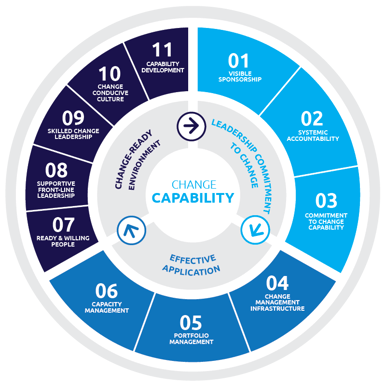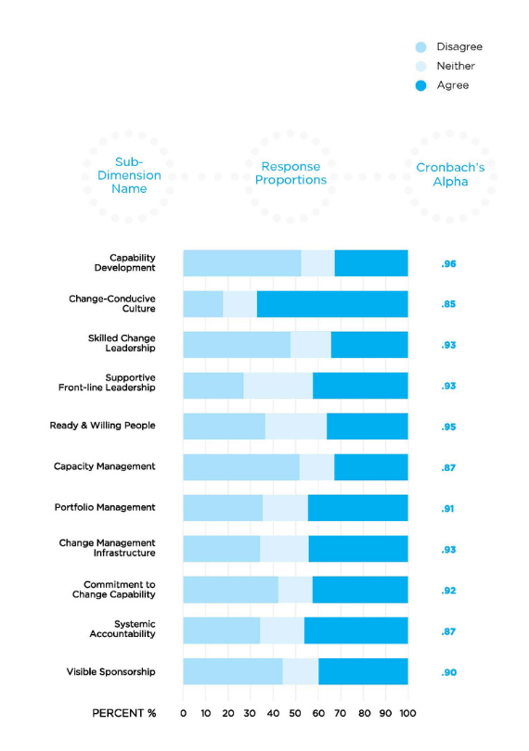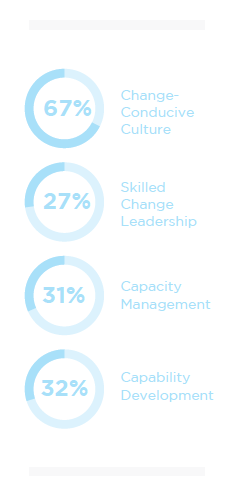- Change – An Organisational Imperative
- Change has Changed
- Defining Change Capability
- A Holistic Model of Change Capability
- Dimension 1: Leadership Commitment to Change
- Dimension 2: Effective Application
- Dimension 3: Change-Ready Environment
- Validating Our Model
- Preliminary Findings & Ongoing Validation
- References
Change – An Organisational Imperative
The rate of change has increased drastically in recent years, with the global business environment becoming increasingly volatile, uncertain, complex, and ambiguous. A trend that is projected to continue with exponential improvements to technology, a demographically changing workforce, and shifts in consumer expectations.
Change is now the number one organisational priority. Managing and introducing change is recognised as the strongest predictor of confidence in leadership, according to 13,124 leaders and 1,528 human resource executives from 2,031 organisations13.
Organisations must be capable of implementing change frequently, quickly, efficiently and successfully in order to remain competitive.
Change has Changed
Traditional step based methodologies of change management are no longer enough. They were sufficient when change was planned, isolated, and episodic. This is no longer the case in a world where the largest taxi company owns no vehicles, the most popular media owner creates no content, the most valuable retailer has no inventory, and the largest accommodation provider owns no real estate(*7).
Two decades ago, John Kotter predicted that change would not slow down. He was right. Today, change and transformation are business as usual and continuous. As such, the per project view of change management is no longer the most effective or efficient. The contemporary business environment does not afford organisations long preparation times anymore, nor does it provide periods of stability for review and improvement.
Current conditions require not only effectively applying sound methodologies, but also a conducive culture, supportive systems, effective processes, and motivated people. These factors contribute to an organisation’s change capability and must be developed over time.
Defining Change Capability
In the simplest of terms, an organisation that is change capable is one that is good at change. Its components facilitate ongoing change and transformation, which help its employees consider change business as usual and not an obstacle to completing their work tasks. As a result, change initiatives are delivered faster, cheaper, and more successfully with less disruption. This means a greater return on investment for each initiative, as well as more opportunities to get ahead of competitors.
Today’s business challenge is to develop change capability. This is how to achieve successful change management.
To help facilitate this, we set out to identify the key components of a change capable organisation and to create a diagnostic to guide organisations’ investments in change.
Popular practitioner descriptions of change capability suggest that change capable organisations need to be able to manage the pressures of change, while meeting and exceeding expectations. Employees must have a shared language of change, be excited by it, and consider it an integral part of their jobs. Methodology should be supported by infrastructure and used consistently in all projects. Change management also needs to be integrated into project management and associated improvement processes, with its impact measured as returns on investment. Finally, change management must have an observable impact on organisational effectiveness.
Relative to the large amount of research in the academic literature on the drivers of individual openness or resistance to change, the theory and research on holistic change capability remains under developed(*12).
McGinness and Morgan(*9), in one of the few theoretically grounded frameworks, theorised change capability as having three essential components:
1. A suitable foundation for incessant change, which requires a culture that is ready for behavioural change because it understands that change is necessary.
2. The ability to shape incessant change, in the form of organisational structures, systems, and processes that support an adaptive organisational climate.
3. Sustaining the energy of incessant change by sustaining employees’ commitment and capacity to create and implement change.
However, as with most existing models of change capability e.g. (*3; 10; 11; 16), the development and validation of McGinness and Morgan’s model is incomplete. More theory and research is needed to establish its core dimensions, which then need to be empirically validated. Only then can a practical diagnostic be developed and used in contemporary organisational contexts with confidence.
A Holistic Model of Change Capability

Our goal was to create an evidence-based change management model that can be used by organisations to reliably assess and develop their change capability. To this end, we reviewed existing definitions and models in the practitioner literature, as well as academic research on factors that increase the likelihood of change success.
After a rigorous review and consultation process, we distilled a prototype model that represents the key elements or dimensions of change capability.
As shown on the previous page, our model contains three main dimensions, each of which subsumes sub-dimensions that provide for a more detailed diagnostic focus. Over the next four pages, we overview each sub-dimension according to its definition, supporting empirical evidence, and provide an example survey question that can be used as part of a diagnostic measure.
Dimension 1: Leadership Commitment to Change
01 Visible Sponsorship
Sample diagnostic item: “Senior leaders create an environment of trust and transparency when undertaking change.”
Senior leaders actively and visibly role-model behavioural changes, while ensuring transparency and encouraging open feedback about change. This was demonstrated in a study(*2) of two public sector organisations of 349 and 425 employees each, where an open climate of communication led to increased trust in senior management. This then reduced employees’ cynicism towards organisational change.
02 Systemic Accountability
Sample diagnostic item: “Senior leaders hold managers accountable for the realisation of change benefits in their area of authority.”
Internal accountability for the realisation of change-related benefits is evident from top to bottom of the organisation. In a study(*4) of over 2,500 project management leaders and practitioners, organisations that were “highly effective” in change focused on concrete ownership and accountability significantly more than those that were “minimally effective” (84 per cent versus 24 per cent).
03 Commitment to Change Capability
Sample diagnostic item: “The senior leadership team consistently communicate the importance of being a change capable organisation.”
Senior leadership understands and publicises the reasons for building change capability. In research(*6) from a major mobile phone manufacturer, active visible support and participation of senior management is likely to provide the necessary momentum for change initiatives.
Dimension 2: Effective Application
04 Change-Management Infrastructure
Sample diagnostic item: “Business rules, policies and procedures are in place to ensure change management is a requirement.”
This means there is a dedicated internal, consistent change management process and structure that ensures the agreed methodology is used across all projects. Consistent use of the same formal methodology resulted in significantly more successful implementation (52 per cent versus 39 per cent), according to a study of over 1,500 change practitioners.
05 Portfolio Management
Sample diagnostic item: “There is a process in place for reassigning and reordering priorities in response to change.”
There is a consistent process for resource assignment and initiative prioritisation that is strategically aligned, informed at all levels, and considers direct and indirect effects of decisions. A study(*4) of over 2,500 project management leaders and practitioners reported strategically aligned initiatives are significantly more likely to be successful than misaligned ones (71 per cent versus 48 per cent).
06 Capacity Management
Sample diagnostic item: “Senior leaders ensure that employees are not overloaded by additional demands, caused by change implementation.”
Leadership at all levels ensures that change demands do not overload employees. This should help to avoid change fatigue, which is reported to be the greatest obstacle to successful implementation in a study1 of over 2,200 executives, managers, and employees.
Dimension 3: Change-Ready Environment
07 Ready and Willing People
Sample diagnostic item: “Our people are motivated and responsive to change.”
A workforce comprised of individuals who are responsive to, motivated by, and ready to deal effectively with change. Out of 164 employees who had recently undergone a merger, those with more positive attitudes about change remained committed to the
organisation after the merge, whereas others had intentions to leave(*5).
08 Supportive Front-line Leadership
Sample diagnostic item: “Middle and front line leaders create an environment of trust and transparency when undertaking change.”
Middle and frontline leadership create an immediate environment of support and openness during change, while redressing issues with change fairly and promptly. A positive working relationship with immediate supervisors was significantly associated with reduced resistance to change in a study of 235 employees of a large housing corporation(*14).
09 Skilled Change Leadership
Sample diagnostic item: “Executives are trained in their role and responsibilities as sponsors of change.”
Leadership at all levels are trained in their role in change. Lack of leadership is one of the top two reported causes of organisational change failure in a study of over 2,500 project management leaders and practitioners(*4).
10 Change-Conducive Culture
Sample diagnostic item: “In this organisation, we think it is normal to deal with constantly evolving initiatives and ideas.”
A change capable organisation has a culture that encourages improvement through experimentation, problem solving, and honest dialogue. For instance, a development climate reduced resistance to change in a sample of 235 employees of a large housing corporation(*14).
11 Capability Development
Sample diagnostic item: “The ability to thrive in a constantly changing environment is reflected in HR processes (e.g. employee selection, evaluation & reward).”Individual change capability is recruited for, developed, and rewarded in the full employee lifecycle. Personality factors like self esteem, optimism, and perceived control, which can be recruited for, significantly increase acceptance of change in a study of 133 government employees(*15).
Validating Our Model
Validation Process
Having distilled the model of change capability from a rigorous review of the published literature, coupled with consultations with change management professionals, we developed a list of 76 survey questions that are reflected in the model’s sub-dimensions.
The validation procedure began with surveying change experts and conducting exploratory factor analyses on the collected data to see if our proposed sub-dimensions were supported. Subsequently, we evaluated the reliability of each sub-dimension measure by calculating its internal consistency. Finally, correlations between each subdimension were calculated to assess the strength of their relationships. Each step of the validation process is explained over the following pages, and preliminary findings are reported.
.png?width=391&name=Validating%20model%20(2).png)
313 people had responded to the invitation to participate in our validation study at the time of analysis. As not all respondents completed the survey, our preliminary analyses are based on 118 complete responses
Most survey respondents had the role of change professionals (68%) and were from Australia (92%). Respondents were experienced in change management, with 40 per cent having had 5 to 10 years in change and 39 per cent having had over 10 years’ experience. There was a wide spread of organisation sizes from less than 1,000 employees (23%) to over 30,000 (26%).
Exploratory factor analysis, a statistical procedure that identifies patterns of responses in collected data, supports the sub-dimensions in our model. It also shows the strength of the relationships between each survey question and each sub-dimension. We have further improved our capability diagnostic by removing the questions that are less strongly related to each sub-dimension or factor.
We then assessed the reliability of the sub-dimensions in our model by evaluating their internal consistencies. The Cronbach’s alpha* values suggest that our survey items are worded appropriately and belong to their associated sub-dimensions (values are shown overleaf).*Cronbach’s alpha interpretation guidelines:
More than .9 = Excellent; .8 to .9 = Good; 0.7 to 0.8 = Acceptable;
0.6 to 0.7 = Questionable; 0.5 to 0.6 = Poor; Less than 0.5 = Unacceptable.
Preliminary Findings

 While data collection and validation is still ongoing, preliminary analyses yielded some interesting results.
While data collection and validation is still ongoing, preliminary analyses yielded some interesting results.
A significantly greater portion of respondents reported that their organisational culture is conducive to change, compared to those who do not (67% vs. 18%).
Only 27 per cent of those surveyed agreed with statements indicating their leadership is trained in their roles, of which more than half only slightly agreed. This is especially noteworthy given PMI’s finding4 that a lack of leadership
is one of the top two obstacles to successful change initiatives.
31 per cent reported that their organisation prevents employees from being overloaded by change demands, which is problematic, as PwC describes change fatigue as the number one cause of failure1.
Capability development was another notable gap, where only 32 per cent indicated that their organisation considered individual change capability in the employee lifecycle.
Ongoing Validation
“You can’t build an adaptable organization without adaptable people – and individuals change only when they have to, or when they want to.” – Gary Hamel
As a final step in the validation process, we conducted correlational analyses to see how strongly each change capability sub-dimension is related to individual willingness and readiness for organisational change. A high Pearson’s coefficient (r)* shows that organisations with high and low ratings of ready and willing people also tend to have high and low ratings of:
- Systemic accountability (r = .63)
- Change-conducive culture (r = .63)
- Visible sponsorship (r = .61)
- Change management infrastructure (r = .60)
- Supportive front-line leadership (r = .60)
Overall, the data and analyses strongly support our model of change capability.
We are still collecting data, as the validation process is ongoing. In future reports, we
will compare change capability by industry, organisational size, and geography.
*Pearson’s coefficient interpretation guidelines: More than .8 = Very Strong; .6 to .8 = Strong; .4 to .6 = Moderate; .2 to .4 = Weak; less than .2 = Very Weak.
*References
- Aguirre, D., von Post, R., & Alpern, M. (2013). Culture’s Role in Enabling Organizational Change Survey Ties Transformation Success to
Deft Handling of Cultural Issues: Berlin: Booz & Company. - 2. Albrecht, S., & Travaglione, A. (2003). Trust in public-sector senior management. International Journal of Human Resource Management, 14(1),
76-92. - Beer, M. (1999). Leading learning and learning to lead: An action learning approach to developing organizational fitness. In J. A. Conger, G. M. Spreitzer & E. E. LAWLER (Eds.), The leader’s change handbook: An essential guide to setting direction and taking action (pp. 127-161). San Francisco: Jossey-Bass.
- Cabrey, T., & Haughey, A. (2014). PMI’s Pulse of the Profession In-Depth Report: Enabling Organizational Change Through Strategic Initiatives. Newtown Square, PA: Project Management Institute.
- Chawla, A., & Kevin Kelloway, E. (2004). Predicting openness and commitment to change. Leadership & Organization Development Journal, 25(6), 485-498.
- Diaz, M., & Sligo, J. (1997). How software process improvement helped Motorola. IEEE software(5), 75-81.
- Goodwin, T. (2015). The Battle Is For The Customer Interface. TechCrunch.
- Jørgensen, H., Owen, L., & Neus, A. (2008). Making change work. IBM Corporation.
- McGuinness, T., & Morgan, R. E. (2005). The effect of market and learning orientation on strategy dynamics: The contributing effect of organisational change capability. European Journal of Marketing, 39(11/12), 1306-1326.
- Meyer, C. B., & Stensaker, I. G. (2006). Developing capacity for change. Journal of Change Management, 6(2), 217-231.
- Oxtoby, B., McGuiness, T., & Morgan, R. (2002). Developing organisational change capability. European Management Journal, 20(3), 310-320.
- Pettigrew, A. M., Woodman, R. W., & Cameron, K. S. (2001). Studying organizational change and development: Challenges for future research. Academy of Management Journal, 44(4), 697-713.
- Sinar, E., Wellins, R. S., Ray, R., Lui-Abel, A., & Neal, S. (2014). Global Leadership Forecast 2014-2015: Development Dimensions International.
- Van Dam, K., Oreg, S., & Schyns, B. (2008). Daily work contexts and resistance to organisational change: The role of leader–member exchange, development climate, and change process characteristics. Applied Psychology, 57(2), 313-334.
- Wanberg, C. R., & Banas, J. T. (2000). Predictors and outcomes of openness to changes in a reorganizing workplace. Journal of Applied Psychology, 85(1), 132.
- Worley, C. G., & Lawler III, E. E. (2006). Designing organizations that are built to change. MIT Sloan Management Review, 48(1), 19-23.



